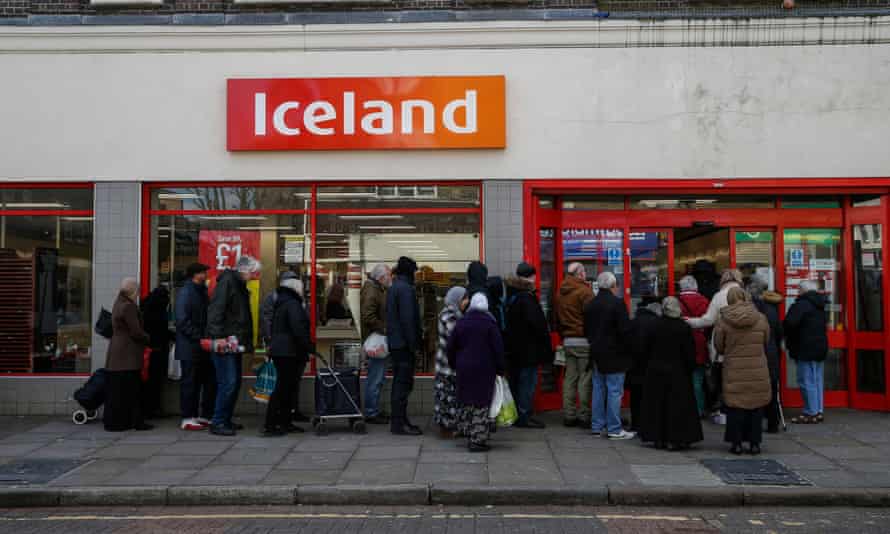ORur ruling class may have been brazenly wheeling suitcases of cheap plonk past the averted gaze of Metropolitan police officers during the last year of lockdowns, but their voters are increasingly finding themselves destitute, hungry, demoralized and priced out of the cheapest bag of apples at the supermarket.
It was reported last week that the consumer price index (CPI) measure for inflation rose to 5.4% in December, the highest level for nearly 30 years. The CPI and the retail price index (RPI) are used interchangeably to document the rising price levels of groceries and household goods across the UK. Yet they only tell a fragment of the story of inflation, and grossly underestimate the true cost-of-living crisis.
A collection of 700 pre-specified goods that includes a leg of lamb, bedroom furniture, a television and champagne seems a blunt and darkly comical tool for recording the impact of inflated grocery prices in a country where two and a half million citizens were forced by an array of desperate circumstances to use food banks in the last year.
The Smart Price, Basics and Value range products offered as lower-cost alternatives are stealthily being extinguished from the shelves, leaving shoppers with no choice but to “level up” to the supermarkets’ own branded goods – usually in smaller quantities at larger prices.
I have been monitoring this for the last decade, through writing recipes on my online blog and documenting the prices of ingredients in forensic detail. In 2012, 10 stock cubes from Sainsbury’s Basics range were 10p. In 2022, those same stock cubes are 39p, but only available in chicken or beef. The cheapest vegetable stock cubes are, inexplicably, £1 for 10. Last year the Smart Price pasta in my local Asda was 29p for 500g. Today, it is unavailable, so the cheapest bag is 70p; a 141% price rise for the same product in more colorful packaging. A few years ago, there were more than 400 products in the Smart Price range; today there are 87, and counting down.
The managing director of Iceland, Richard Walker, stated on ITV on Friday that his stores were losing customers “to food banks, and to hunger”. Not to other competitors, not to better offers, but to starvation, and charity. Iceland has pledged to keep its £1 lines at the flat rate of £1 until the end of the year, a commitment to customers at the sharp end that is rare in the cut-throat world of supermarket retail.

Last Thursday I was contacted on Twitter by an elderly gentleman who confessed he had eaten a teaspoon of toothpaste for his dinner in order to fool himself into thinking he had chewed, swallowed, tasted and digested something. I relayed this, on good morning britain, to the business secretary, Kwasi Kwarteng, who said he was “appalled” that such things happened in Britain today. Appalled but unsurprised, perhaps, considering the eradication of social support has been Conservative policy for 12 long years.
People with very little are often the sharpest of economists and mathematicians, holding dozens of prices in our heads so we can remove objects from the shopping basket at the checkout when the total comes to more than the pittance in our bank account. Juggling late and delayed benefit payments, knocking a bit off each bill to keep the wolves from the door, shopping around for the cheapest school uniform that won’t fall apart in the washing machine, and scrutinizing the shelf-edge labels for the “price per 100g” of each product, ignoring the brightly colored offers.
I have been writing about these things for 10 years now. I have given evidence to multiple parliamentary inquiries, led numerous petitions, been consulted on the School Food Plan and the National Food Strategy, spoken twice at the Conservative party conference, and still the realities of the worst of our collective experiences are dismissed by haughty money men as not matching their theoretical lamb-and-champagne metrics.
So, along with a team of economists, charitable partners, retail price analysts, people working to combat poverty in the UK, ex-staff from the Office for National Statistics and others who have volunteered their time and expertise, I am compiling a new price index – one that will document the disappearance of the budget lines and the insidiously creeping prices of the most basic versions of essential items at the supermarket.
At the very least, it will serve as an irrefutable snapshot of the reality experienced by millions of people. At its best, it may be a warning shot to retailers who keep their £7.50 ready meals and £6 bottles of wine at £7.50 and £6 for a decade, while quadrupling the price of basic stock cubes and broken irregular grains of white rice .
This issue isn’t going anywhere, and neither am I.
www.theguardian.com
George is Digismak’s reported cum editor with 13 years of experience in Journalism